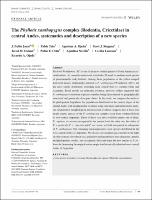| dc.creator | Jayat, Jorge Pablo | |
| dc.creator | Teta, Pablo Vicente | |
| dc.creator | Ojeda, Agustina Alejandra | |
| dc.creator | Steppan, Scott J. | |
| dc.creator | Osland, Jared M. | |
| dc.creator | Ortiz, Pablo Edmundo | |
| dc.creator | Novillo, Agustina | |
| dc.creator | Lanzone, Cecilia | |
| dc.creator | Ojeda, Ricardo Alberto | |
| dc.date.accessioned | 2023-08-25T13:00:12Z | |
| dc.date.available | 2023-08-25T13:00:12Z | |
| dc.date.issued | 2021-08-09 | |
| dc.identifier.citation | Jayat, J.P., Teta, P.V., Ojeda, A.A., Steppan, S.J., Osland, J.M., Ortiz, P.E…Ojeda, R.A. (2021). The Phyllotis xanthopygus complex (Rodentia, Cricetidae) in central Andes, systematics and description of a new species. Zoologica Scripta. Reino Unido: Wiley Blackwell Publishing, 50 (6), pp. 689-706. | es_AR |
| dc.identifier.issn | 0300-3256 | |
| dc.identifier.other | 27047 | |
| dc.identifier.other | CCPI-CNyE-A-192 | |
| dc.identifier.uri | https://hdl.handle.net/20.500.12219/5092 | |
| dc.description | Fil: Jayat, Jorge Pablo. Consejo Nacional de Investigaciones Científicas y Técnicas. Centro Científico Tecnológico (Tucumán). Unidad Ejecutora Lillo; Argentina | es_AR |
| dc.description | Fil: Teta, Pablo Vicente. Museo Argentino de Ciencias Naturales “Bernardino Rivadavia”. División Mastozoología; Argentina. | |
| dc.description | Fil: Ojeda, Agustina Alejandra. Consejo Nacional de Investigaciones Científicas y Técnicas. Instituto Argentino de Investigaciones de las Zonas Áridas (Mendoza); Argentina. | |
| dc.description | Fil: Ojeda, Agustina Alejandra. Universidad Nacional de Cuyo. Instituto Argentino de Investigaciones de las Zonas Áridas (Mendoza); Argentina. | |
| dc.description | Fil: Steppan, Scott J. Florida State University; Estados Unidos. | |
| dc.description | Fil: Osland, Jared M. Florida State University; Estados Unidos. | |
| dc.description | Fil: Ortiz, Pablo Edmundo. Consejo Nacional de Investigaciones Científicas y Técnicas. Centro Científico Tecnológico(Tucumán). Instituto Superior de Correlación Geológica; Argentina. | |
| dc.description | Fil: Ortiz, Pablo Edmundo. Universidad Nacional de Tucumán. Instituto Superior de Correlación Geológica; Argentina. | |
| dc.description | Fil: Novillo, Agustina. Consejo Nacional de Investigaciones Científicas y Técnicas. Centro Científico Tecnológico (Tucumán). Instituto de Biodiversidad Neotropical; Argentina. | |
| dc.description | Fil: Novillo, Agustina. Universidad Nacional de Tucumán. Instituto de Biodiversidad Neotropical; Argentina. | |
| dc.description | Fil: Lanzone, Cecilia. Consejo Nacional de Investigaciones Científicas y Técnicas. Instituto de Biología Subtropical. Laboratorio de Genética Evolutiva; Argentina. | |
| dc.description | Fil: Lanzone, Cecilia. Universidad Nacional de Misiones. Instituto de Biología Subtropical. Laboratorio de Genética Evolutiva; Argentina. | |
| dc.description | Fil: Ojeda, Ricardo Alberto. Consejo Nacional de Investigaciones Científicas y Técnicas. Centro Científico Tecnológico (Nordeste). Instituto de Biología Subtropical; Argentina. | |
| dc.description | Fil: Ojeda, Ricardo Alberto. Universidad Nacional de Cuyo. Instituto Argentino de Investigaciones de las Zonas Áridas (Mendoza); Argentina. | |
| dc.description.abstract | Phyllotis Waterhouse 1837 is one of the most studied genera of South American cricetid rodents. As currently understood, it includes 20 small to medium-sized species of predominantly rocky habitats. Among them, populations of the yellow-rumped leaf-eared mouse, traditionally referred to P. xanthopygus (Waterhouse 1837), are the most widely distributed, extending from central Peru to southern Chile and Argentina. Based mostly on molecular evidence, previous studies suggested that P. xanthopygus constitutes a species complex, being characterized by geographically structured and genetically divergent clades. In this work, we compare the molecular phylogenetic hypothesis for populations distributed on the eastern slopes of the central Andes with morphometric evidence using univariate and multivariate analyses. Quantitative morphological and molecular evidence suggests that at least four nearly cryptic species of the P. xanthopygus complex occur from southern Bolivia to west-central Argentina. Three of these taxa have available names; one of them, P. caprinus, is currently recognized to the species level; the other two, the clades of P. x. posticalis-P. x. rupestris and P. vaccarum, are both recognized as subspecies of P. xanthopygus. The remaining taxon represents a new species distributed in the west-central Andes of Argentina. We discuss our morphological results in the light of other sources of evidence (e.g. qualitative and quantitative state characters, genetic and phylogenetic studies, and cytogenetic data) and name the new species as P. pehuenche, honouring the original native people that historically inhabited west-central Andes of Argentina. | es_AR |
| dc.format | application/pdf | |
| dc.format.extent | 2.4 MB | |
| dc.language.iso | eng | es_AR |
| dc.publisher | Wiley Blackwell Publishing | es_AR |
| dc.relation | info:eu-repo/semantics/altIdentifier/hdl/http://hdl.handle.net/11336/170437 | |
| dc.relation | info:eu-repo/semantics/altIdentifier/doi/http://dx.doi.org/10.1111/zsc.12510 | |
| dc.relation | info:eu-repo/semantics/altIdentifier/urn/https://par.nsf.gov/servlets/purl/10325983 | |
| dc.rights | info:eu-repo/semantics/openAccess | |
| dc.subject | Cryptic species | es_AR |
| dc.subject | Integrative taxonomy | es_AR |
| dc.subject | Myomorpha | es_AR |
| dc.subject | New species | es_AR |
| dc.subject | Phyllotini | es_AR |
| dc.subject | Sigmodontinae | es_AR |
| dc.title | The Phyllotis xanthopygus complex (Rodentia, Cricetidae) in central Andes, systematics and description of a new species | es_AR |
| dc.type | info:eu-repo/semantics/article | es_AR |
| dc.type | info:ar-repo/semantics/artículo | |
| dc.type | info:eu-repo/semantics/publishedVersion | |



